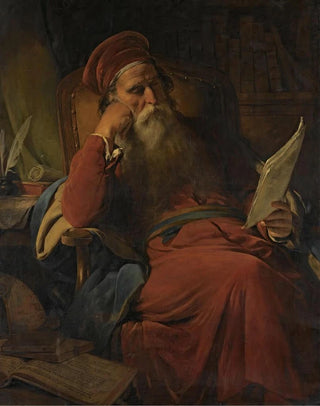Art print | A scholar in his office - Friedrich von Amerling


View from behind

Frame (optional)
In the vast panorama of art history, some works stand out for their ability to capture the very essence of human intellect. "An Scholar in His Office" by Friedrich von Amerling is undoubtedly one of these masterpieces. Painted in the 19th century, this canvas immerses us in an intimate universe where knowledge and contemplation meet. The viewer is invited to enter the world of a scholar, whose posture, environment, and surrounding objects evoke deep reflection on knowledge. The soft light flooding the scene creates a warm, almost meditative atmosphere, where every detail seems imbued with meaning.
Style and uniqueness of the work
Friedrich von Amerling's style is characterized by striking realism, combined with meticulous attention to detail. In "An Scholar in His Office," the finesse of textures—whether of books, curiosities, or the scholar's clothing—demonstrates remarkable technical mastery. The color palette chosen by the artist, with its shades of brown, gold, and green, helps establish an ambiance that is both serene and intellectual. The composition is carefully balanced, highlighting the protagonist while integrating the surrounding environment. Elements of nature, such as the light filtered through the window, evoke a connection between interior and exterior, symbolizing the pursuit of knowledge that transcends the walls of the office. Every object, every book, seems to tell a story, encouraging the viewer to ponder the life of this scholar.
The artist and his influence
Friedrich von Amerling, born in 1803 in Vienna, was an Austrian painter whose work is rooted in the realism movement. Raised in an artistic environment, he developed a style that combines a keen sense of observation with aesthetic sensitivity. Amerling was particularly renowned for portraiture, but his ability to capture scenes of everyday life, such as that of the scholar in his office, reveals a profound understanding of human psychology. His influence extends beyond his era, inspiring generations of artists to explore themes of intellect,

Matte finish

View from behind

Frame (optional)
In the vast panorama of art history, some works stand out for their ability to capture the very essence of human intellect. "An Scholar in His Office" by Friedrich von Amerling is undoubtedly one of these masterpieces. Painted in the 19th century, this canvas immerses us in an intimate universe where knowledge and contemplation meet. The viewer is invited to enter the world of a scholar, whose posture, environment, and surrounding objects evoke deep reflection on knowledge. The soft light flooding the scene creates a warm, almost meditative atmosphere, where every detail seems imbued with meaning.
Style and uniqueness of the work
Friedrich von Amerling's style is characterized by striking realism, combined with meticulous attention to detail. In "An Scholar in His Office," the finesse of textures—whether of books, curiosities, or the scholar's clothing—demonstrates remarkable technical mastery. The color palette chosen by the artist, with its shades of brown, gold, and green, helps establish an ambiance that is both serene and intellectual. The composition is carefully balanced, highlighting the protagonist while integrating the surrounding environment. Elements of nature, such as the light filtered through the window, evoke a connection between interior and exterior, symbolizing the pursuit of knowledge that transcends the walls of the office. Every object, every book, seems to tell a story, encouraging the viewer to ponder the life of this scholar.
The artist and his influence
Friedrich von Amerling, born in 1803 in Vienna, was an Austrian painter whose work is rooted in the realism movement. Raised in an artistic environment, he developed a style that combines a keen sense of observation with aesthetic sensitivity. Amerling was particularly renowned for portraiture, but his ability to capture scenes of everyday life, such as that of the scholar in his office, reveals a profound understanding of human psychology. His influence extends beyond his era, inspiring generations of artists to explore themes of intellect,






